Last night my husband asked, “Are you ever going to blog again?” So here I am. Blogging again. Perhaps this isn’t the best welcome back post for some, but this is our life. Last summer I blogged about processing chickens here with the title Chickens: Not for the Sqeamish. That title still applies. Take heed and click to another blog if you have a weak stomach. This post will detail how we’ve processed about 90 chickens this summer–54 this past Monday. Wouldn’t you love to be invited to Family Home Evening at our house in the summer!
Last year we used a skinning method. This year we tried the time-old dunking technique.
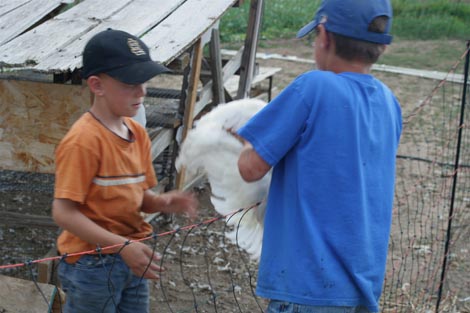 This is a family operation and everyone contributes. My husband’s brother, Matt and his family are raising broilers too, so we processed our chickens together. Plus, he has all the connections to borrow the equipment we used. Here my nephew (in the orange) catches the chickens and hands them to my son. Never fear, each chicken was named before it died.
This is a family operation and everyone contributes. My husband’s brother, Matt and his family are raising broilers too, so we processed our chickens together. Plus, he has all the connections to borrow the equipment we used. Here my nephew (in the orange) catches the chickens and hands them to my son. Never fear, each chicken was named before it died.
My nephew: What should we name this one?
My son: I don’t know.
My nephew: How about Spikey?
My son as he places the chicken in the kill cone: Ouch! We should call him Dangerous.
My nephew: Why?
My son: Because he just bit me.
(This would be a good time to leave if you faint at the sight of blood.)
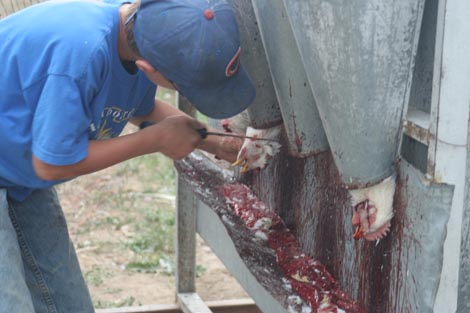 Then my son proceeded to slit the chicken’s throat. I explained in my other chicken post how the chicken bleeds out so fast that first it faints and then it dies pretty painlessly.
Then my son proceeded to slit the chicken’s throat. I explained in my other chicken post how the chicken bleeds out so fast that first it faints and then it dies pretty painlessly.
Once the chickens have bled out, the boys toss them into the wheelbarrow. When the wheelbarrow is full, they wheel it up to us where
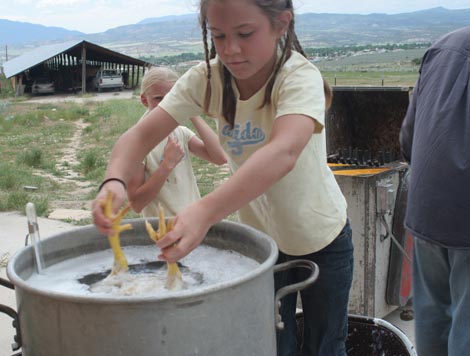 my girl dunks the now dead chicken into a pot of 150° water. Yeah, my lucky sister-in-law, Stacy, had to donate her candy thermometer to the cause.(Hotter than this and the skin will sluff off in the defeather. Cooler and the feathers won’t come out.) My girl moves the legs back and forth and pulls the chicken out. Then repeats the process six or seven times before pulling the chicken out and letting it drain over the pot. Then she hands it off to my brother-in-law, Matt.
my girl dunks the now dead chicken into a pot of 150° water. Yeah, my lucky sister-in-law, Stacy, had to donate her candy thermometer to the cause.(Hotter than this and the skin will sluff off in the defeather. Cooler and the feathers won’t come out.) My girl moves the legs back and forth and pulls the chicken out. Then repeats the process six or seven times before pulling the chicken out and letting it drain over the pot. Then she hands it off to my brother-in-law, Matt.
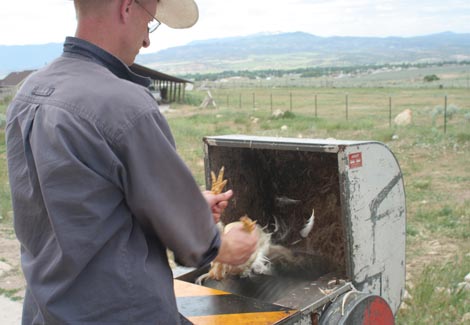 Matt turns the chicken over as the nubby drum spins and removes the feathers.
Matt turns the chicken over as the nubby drum spins and removes the feathers.
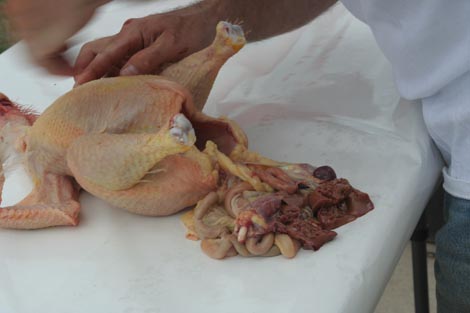 Matt hands the chicken over to Nate for beheading and innard removal.
Matt hands the chicken over to Nate for beheading and innard removal.
 He passes the chicken to our girl who removes the feet. (Thanks Matthew Buckley for enlighting my children as to how to make a chicken’s foot move once it’s been removed.)
He passes the chicken to our girl who removes the feet. (Thanks Matthew Buckley for enlighting my children as to how to make a chicken’s foot move once it’s been removed.)
 Next the chicken goes to quality control where my sister in-law and niece remove any missed feathers. Then I rinse the chicken inside and out and place it in a cooler of ice water and a bit of clorox. Ideally, they should age for four hours in the ice water. Then we give each chicken a final and thorough rinse, place it in a Ziploc freezer bag, and put it in the freezer.
Next the chicken goes to quality control where my sister in-law and niece remove any missed feathers. Then I rinse the chicken inside and out and place it in a cooler of ice water and a bit of clorox. Ideally, they should age for four hours in the ice water. Then we give each chicken a final and thorough rinse, place it in a Ziploc freezer bag, and put it in the freezer.
Now aren’t you glad I came back into the blogging world to share all of this with you?





Love it! Glad you’re back.
What made you decide to do the dunking method instead of the skinning method? We skin because it seems much easier and we don’t eat the skin anyway. And by the way, I don’t see any pictures of your husband. Where was he during all the fun?
I AM glad you’re back. The squeamish who turn away from this post miss seeing the work ethic you have taught your children. Wow. I am very impressed. That is my big struggle with my children. I’ve always tried to get them to work, but somehow I’ve created more eye rolling than useful skill sets. How do you do it?
Oh Nate’s there. Those are his hands in the gutting picture. Two things. First, the meat was so DRY when we used the skinning method. I always had to marinate it or shred it and cook in some sort of sauce. Secondly, this method was a whole lot cleaner due to the hot bath.
Jenni, I just don’t take pictures of the eye rolling. 🙂 Seriously though, some of the jobs were more exciting for the boys than girls. Yes, I’m pointing out gender stereotypes, but there’s a reason they exist. Having cousins around helped out, too.
That is so cool. That nubby drum is the ticket. I had to pluck by hand. That is so much easier.
I can just imagine, the family setting there everyone doing their job.
Did you smile with pride at what was taking place?
A rare thing nowdays indeed.
Robert, seriously, you plucked by hand? How long did that take for each chicken?
Oh, my! And I thought my house-fly rampages were gruesome!